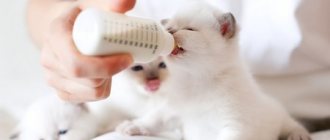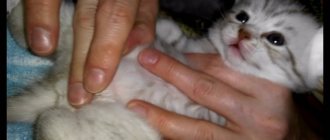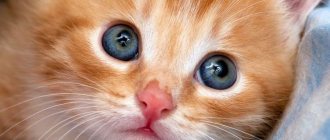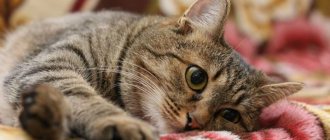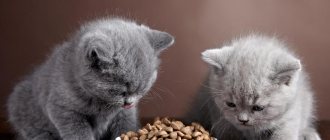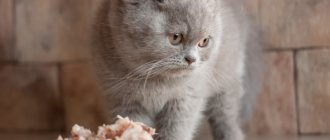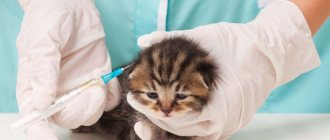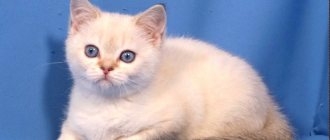The appearance of a kitten in the house is exciting. The baby seems helpless and defenseless. The baby cannot feed himself, and the owner needs tips. In this article we have collected useful and important information about feeding your pet. We figured out the intricacies of natural feeding and the first feeding of a newborn kitten. We found out how to create a menu for a cat in the first months of its life and what foods to avoid. Also from the article you will learn when a kitten will start eating from a bowl on its own and how to teach it to do so.
At what age do kittens start eating on their own?
Under natural conditions, breastfeeding in kittens continues for a long time. The number of feedings is noticeably reduced by 2-2.5 months, and in cases where the cat has a small litter, she can continue feeding for up to six months. However, in order for your little pet to easily and painlessly switch to independent feeding, complementary foods should be introduced from three weeks of age.
A kitten should be taught to feed itself from three weeks of age.
The first weeks of a kitten’s life are the most delicate, so you need to pay attention to the baby’s nutrition. To start complementary feeding, liquid porridge is suitable. And when the kittens reach two months and their baby teeth begin to appear, solid food can be introduced. With the right and patient approach, by the age of 10 weeks the pet will be able to completely switch to solid food.
Remember that the diet must be balanced and contain the necessary elements for harmonious development. It is important to decide from the very beginning what type of complementary feeding you will use and strictly adhere to it in the future: industrial or natural. Both options can provide your little friend with the necessary vitamins and minerals, so be guided by your capabilities. However, they cannot be mixed: the digestion of dry and natural food requires different enzymes and an acidic environment. Alternating food will inevitably lead to gastrointestinal problems for your cat.
Without mother's milk
A newborn kitten needs to be fed with special formulas.
If for some reason a kitten cannot eat mother's milk in the first weeks of life, the owner will have to take on the responsibilities of the mother cat.
Remember that cat milk has a certain composition and any substitutes must be suitable for a young and sensitive body. You can purchase dry formula for feeding at a veterinary pharmacy. But they are quite expensive, so you can do the preparation yourself. Here are some recipes:
- 0.5 liters of concentrated milk, egg yolk and 4 teaspoons of granulated sugar;
- 50 g whole cow's milk, 15 g whole milk powder, 2.5 g dry yeast;
- 50 ml of whole milk, 50 g of boiled milk, half a raw egg yolk, a teaspoon of corn oil;
- Dilute concentrated milk powder in fennel broth to the consistency of liquid gruel, adding a little cream;
- a glass of 6% milk, 1 raw egg, 1 teaspoon of honey (instead of milk, you can take 10% cream, dilute with boiled water 2 times).
Cow's milk is dangerous for kittens!
Important! Do not feed your baby whole cow's milk. It does not have sufficient nutritional value and may cause digestive upset.
Regular food
Not all food that is common in human terms is suitable for a cat. A cat's stomach is delicate and sensitive, so when choosing natural complementary foods, carefully consider the list of products in your pet's diet. The wrong choice of food will provoke allergic reactions, digestive problems and even serious diseases, such as urolithiasis or gastritis. The following products are clearly prohibited for your furry friend:
- cow's milk. As we have already written, it differs in composition from cat milk, so do not try to replace natural feeding with it. It may be dangerous;
- fermented milk products with high fat content;
- freshwater and raw fish. A contented cat with a fish in its mouth is nothing more than a myth. Freshwater and raw fish can serve as a source of worms and cause urolithiasis. It is up to the owner to decide whether to introduce sea fish into the diet or not. In general, it is not dangerous, but its introduction as complementary food is not necessary at first;
It is better to leave the fish to the owners
- sausage and sausage products. It’s hard to resist the temptation to share leftovers from the holiday table with your pet, but remember that due to the high fat content and content of salt and spices, such a product will be too heavy for the cat;
- Cats do not digest potatoes in any form, so we will also include them in the list of cat prohibited foods;
- legumes Peas, beans, soy and other legumes will cause painful bloating;
- cheese has a high fat content that a kitten’s stomach cannot handle;
- pork;
- chocolate. Chocolate is a common cause of cat poisoning encountered by veterinary clinics. Chocolate contains the poison methylxanthine, or theobromine, which can cause tremors, convulsions in a kitten, increase the frequency of heart muscle contractions and even lead to death. Interesting fact: despite the fact that dark chocolate is considered healthier than milk chocolate, it contains 10 times more substances that are toxic to cats;
- flour.
It's better to leave sweets for people
The list of food dangerous for kittens is impressive, but do not rush to panic and go for industrial food. Something in your refrigerator will probably be suitable for the diet of a small pet. For example, vegetable and semolina porridge, low-fat cottage cheese, boiled egg yolk. It is important to ensure that dishes do not contain spices or additives.
How to teach a kitten to eat solid food on its own
In some cases, problems may arise when introducing solid food into a kitten’s diet, so you need to follow these simple rules:
- You can try placing small pieces of food directly into the kitten’s mouth. This way he will taste the product and subsequently will not refuse it, but will eat it with pleasure;
- As an initial complementary food, you can use dry food, which is pre-soaked in water. The initial quantity should not exceed 2 pieces;
- When introducing solid foods, you need to pay attention to the baby’s taste preferences (some kittens love cottage cheese, while others are delighted with fish). Based on the information received, a daily diet is compiled;
- It is recommended to start introducing solid foods with liquid porridges (semolina or crushed corn grits are considered the best option);
- dry forms are given to small kittens only after all their teeth have formed.
Kittens begin to eat on their own when they reach the age of 1–1.5 months. Before this time comes, you should try to teach your pet to drink milk and gradually diversify its diet by introducing other products.
Is the kitten hungry?
It would be wonderful if kittens could tell us about their needs. But in reality, owners have to guess about the children’s desires by their behavior. How to understand that a kitten is hungry?
After feeding, your baby's tummy should be rounded and firm, but not bloated. After eating, the kitten should not meow or try to grab a finger. If he is full, he will calmly fall asleep or cuddle up to his mother. A shrill squeak and attempts to bury your face in search of the cat should be a signal for feeding. Checked on Orphogrammka up to this point
A hungry kitten will squeak and look for its mother
If the kitten squeaks and crawls around its mother, but does not take the nipple, bring a finger dipped in milk to its muzzle. If the kitten tries to suck on it, it means he is hungry and you need to help him find the nipple.
How to train kittens to eat on their own
If the kitten has a mother, the process of learning to feed itself will be easier. The cat itself will take its offspring to the bowl and set an example, and the kittens will try to pick it up. But if the kitten is left without a mother, do not despair: teaching kittens to feed on their own is quite simple.
It's better to learn with milk
The best product to try for the first time is milk. Dip your finger in it and let the kitten try it. Make sure he tries it. Then pour some milk into a bowl and bring the kitten to it. Gently tip its muzzle into the food. Most likely, at first he will not like it, but then he will recognize the taste of milk that is already familiar to him and will try to lap it up.
Let the kitten taste the milk
Don’t expect your pet to immediately run to the bowl and start eating from it: first, he needs to get used to the container and learn to lap. At first, the baby's attempts to lap from the bowl will look funny; he may snort and dirty his face. Be patient: he is learning a completely new feeding technique, because before this he only suckled his mother's milk.
How to accustom a kitten to a bowl?
Owners often wonder at how many months should a kitten start eating from a bowl? By the age of three weeks, kittens show curiosity about food, or rather, about the habits of their mother. That is why you can make your first attempts to accustom a kitten to a bowl already at this age. To ensure everything goes smoothly, follow these guidelines:
- Fill the bowl with milk the first time. The milk should be heated to 37 -38 degrees. Kittens will refuse to lap if the milk is too hot or cold;
- don’t be lazy to let the contents of the bowl taste by bringing your finger with food to your muzzle;
- the kitten may refuse the bowl if its height does not suit him. Therefore, buy containers in pet stores, taking into account the dimensions of your pet;
The bowl should be the right size
- if you manage to quickly make friends with dishes, gradually replace milk with semolina porridge;
It's more fun in a bowl
- kittens can get into the bowl with all four paws, and this needs to be nipped in the bud. If the kitten climbs into a container of food, take it out, wipe its paws and place it in front of it. Hold him if he wants to climb into it again: this way you can teach your pet that his paws should not be in the food.
Why might a kitten refuse to eat?
From time to time, the kitten may refuse to eat. This may happen because you started teaching him to feed himself prematurely. In this case, it is better to start feeding the kitten with a pipette again or return it to the cat. After some time, you can try again to teach the kitten to eat on its own.
The kitten will not be able to start eating without help if the bowl is very large or unstable, as the kitten is not yet dexterous. Buy a bowl that fits his size and is stable on the floor. Then the little animal will feel comfortable and be more willing to eat from this bowl.
The kitten may not like the food if it is very hot or cool. The kitten should be fed food that is not very hot, preferably at room temperature. Moreover, the baby may have health problems. Because of these problems, the kitten will not be able to feed on its own. If you notice the first signs that indicate this, it is better to go to the veterinarian.
Some rules to help you in this matter There are quite a few opinions about what is best for a kitten. However, there are rules that must be followed: The saucer must always be clean and suitable for a small kitten. There should be a bowl of water next to the bowl of food. Feed the kitten according to its age and needs. If necessary, with the permission of the veterinarian, you can give the kitten vitamins.
If the kitten goes to the toilet often, it means he has enough food. Don't force him to eat. Do not mix dry and natural products (unless you are switching from one product to another). After your pet has eaten, you can massage the belly to get the digestive system working.
With a little persistence and understanding, within a week the kitten will learn to eat without assistance. And this is not so important when you teach your pet to eat from a bowl, the main thing is patience. You just need to give him time to get used to food other than his mother's milk.
First weeks of life
Until the baby is one month old, he is fed about 8 times a day, or every 2-3 hours. By the age of three weeks, you can start introducing complementary foods. This should be liquid food, for example:
- vegetable and meat puree;
- low-fat cottage cheese without additives. We recommend diluting it with milk so that the cottage cheese has a liquid consistency;
- semolina porridge without sugar, also diluted with milk.
At three weeks of age, kittens are not yet able to eat on their own from a bowl, so give them their first complementary foods on a spoon or finger. At what age will a kitten be ready to start eating from a bowl on its own? If you start complementary feeding at three weeks, by the time he reaches a month he will be able to feed on his own.
When the baby is five weeks old, you should feed him 5-6 times a day. From now on, you can include boiled yolk in the menu.
Introduce complementary foods carefully, in small portions. Give your kitten time to try new foods. Despite their early curiosity about food, it will take effort for them to get used to the new feeding environment. Until the baby is one month old, stroke his tummy with your finger for better absorption of food.
Age-related dietary patterns
It is not enough to know at what age kittens begin to eat themselves; it is important to take into account the age characteristics of the animal in order to provide the growing body with all the necessary substances for normal development. First of all, it is advisable to adhere to the following diet plan:
- up to the age of 2 weeks – 10 times a day, including night feedings;
- at one month of age - 8 times a day including night;
- from 1 to 2 months, night feedings should be excluded; during the day the kitten receives food 7 times;
- from 2 to 3 months – 6 times a day;
- 4-5 months – 5 times a day;
- from 5 to 9 months, the feeding regimen is reduced to 4 times a day, and after that the kitten is transferred to three meals a day;
- Starting from the age of one, an adult cat should be fed no more than 2 times a day.
It is worth considering the amount of food depending on age; approximate data is presented in the table:
| Kitten age | Amount of food |
| 1 Week | 30 ml per 100 grams of animal weight |
| 2 week | 38 ml |
| 3 week | 48 ml |
| 4 week | 48-53 ml |
| 1.5 months | 120 g of food per day, regardless of weight |
| 2 months | 150 g |
| 3-6 months (growth activation) | 180-240g, 40g is pure meat |
| 6-10 months | 180 g |
| 10-12 months | 150-200 g |
Feeding a two month old kitten
At two months, kittens develop baby teeth. This is an excellent age when introducing a kitten to solid food is simple and natural. But don’t rush to remove liquid foods from your pet’s diet: at two months of age, they are still important for the formation of the proper functioning of the digestive system. At this age, kittens are given:
- boiled lean meat;
- natural yogurt;
- low-fat cottage cheese;
- milk;
- boiled yolk.
At two months the kitten is ready for solid food
Feeding a three month old kitten
At the age of three months, kittens' teeth change, their bones become stronger, they are playful and full of energy. They still need to be fed 5-6 times a day, but the required volumes change: for 1 kilogram of the kitten’s weight there are 200 grams of food per day. During this period, kittens need food rich in protein, and liquid food should make up less than half of the diet. For normal development of eyes and vision, taurine, which is found in meat, is necessary. Add vegetable dishes too. Enter into the menu:
- boiled lean meat - chicken, beef, turkey;
- if there are no worms, you can give raw frozen meat, chopped into small pieces;
- natural yogurt and kefir without additives;
- liquid cottage cheese;
- zucchini, pumpkin, cabbage in raw grated form. If the kitten resists, add grated vegetables to the porridge;
- boiled egg yolk;
- sea fish;
- semolina and rice porridge with milk.
The kitten started eating
Any mother is naturally endowed with a wonderful instinct of caring for her offspring. Helpless babies will not survive without a reverent mother's attitude. And if in the human world a mother’s care has no expiration date, then cats are ready to let their little ones go from their hearts after just 3 weeks. In the wild, cubs immediately learn to get their own food, but kittens living in an apartment have to rely on their owner. Inexperienced owners have no idea whether to allow the kitten to eat on its own or what to include in its diet. This baby is so small and fragile that mistakes are unacceptable. So, how to properly organize the independent feeding of a fluffy mustache?
Age-related nuances of the cat’s “table”
Cats allow their children to live independently early, but are ready to provide them with milk for up to 2 months if necessary. Domestic kittens are usually ready for complementary feeding after 3 weeks of life. In addition, the children are growing rapidly, and it is becoming increasingly difficult for the cat mother to feed this horde.
At the age of 1-1.5 months, the kitten should receive warm liquid food 5-6 times a day. The following dishes can be placed on the cat’s “table”:
- baby meat and vegetable puree;
- semolina porridge with milk without sugar;
- mashed boiled yolk (a little);
- low-fat cottage cheese.
By 2 months, when the first baby teeth emerge, feline babies are ready to try solid food. But you shouldn’t exclude liquid food, as it is good for digestion. Don’t forget: the kitten is growing and developing rapidly, and every day its need for nutrients increases. The better nutrition that is “invested” in the baby at this age, the stronger his health will ultimately be. The following products are suitable for the table:
- lean boiled meat;
- children's cottage cheese;
- cereals (oatmeal, buckwheat, rice);
- chicken yolk;
- fermented milk products and milk;
- low-fat cheese without salt;
- natural yoghurts.
By 3 months, the baby can be switched to dry cat food. Don't skimp on your pet's health. Economy class food is often made up at random from meat and bone waste; it will not be able to fully saturate the cat’s body with the necessary substances. It is better to buy super premium kitten food. From the owner's refrigerator, a three-month-old baby will benefit from the following delicacies:
- lean boiled meat, cut into pieces;
- offal (beef heart/liver);
- boiled sea fish;
- fermented milk cuisine;
- grated vegetables and fruits;
- salad of finely chopped greens and olive oil;
- chicken yolk;
- cereals (rice, buckwheat, millet, rolled oats);
- natural yogurt.
To prevent your cat from being capricious in the future, you need to accustom him to the right table from childhood. It is not uncommon for cats to become hooked on a certain type of food and refuse others that are no less healthy. One regular dish cannot contain all the vitamins a cat needs. And if you want your pet to be an omnivore, teach him to eat fruits, vegetables and cereals from early childhood.
Newborn without mother
It happens that for some reason newborn babies are left without breast milk. Then the owner will face a real test, which will take a lot of time and effort, but will save the little cat’s life. The participation of a veterinarian in this feat is mandatory. A specialist will help you choose food and explain all the nuances of replacing cat milk with cow milk.
Up to 3-4 weeks, babies are fed 8 times a day using a pipette. The milk must be warm (but not higher than 37 degrees). If you drop it on the back of your hand, you can determine the temperature. The skin should not be hot. From 1 to 2 months, you can continue to feed the kitten with milk using a pacifier. After feeding, experts recommend gently massaging the cat's belly so that the digestive system works correctly.
The most important thing in feeding newborn kittens is not to overfeed the baby. Excess milk has an extremely detrimental effect on the fragile health of the baby.
In a sense, it is better to underfeed the baby than to risk his condition. The veterinarian will help determine the dosage of food.
Drinking regime
It is unnatural for cats to drink a lot of water. They have evolved in such a way that their water needs are almost completely satisfied by the moisture content of their food. So don't worry if your kitten seems to quench its thirst very quickly.
The daily water requirement for a kitten is calculated using a simple formula: body weight multiplied by 0.03. The resulting value includes the water contained in the feed. How much moisture is in the food is indicated on the product label as part of a guaranteed analysis. The moisture content is very different between wet and dry food and the owner should take this into account when feeding the baby.
The kitten must have access to clean water
Give your kitten clean, filtered water. The stale smell will scare the baby away and he will not drink. Also, milk and any other liquids other than water will not work.
Cats like wide bowls because they don't like their whiskers touching anything.
